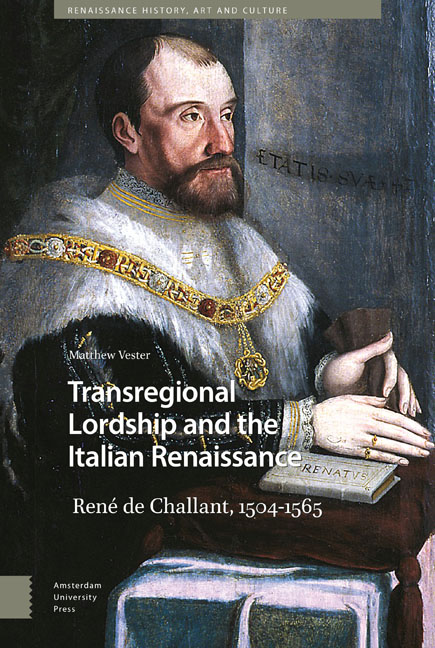Book contents
- Frontmatter
- Contents
- Maps and Tables
- Abbreviations
- Acknowledgments
- 1 On the edge of the Italian Renaissance
- 2 René's early career to 1536
- 3 René's growing influence during the war years, 1536-1553
- 4 René and Duke Emanuel Filibert
- 5 Kinship and noble life
- 6 The Challant political networks
- 7 Finance and brokerage
- 8 Lordship
- 9 The embodiment of spatial politics
- About the author
- Index
6 - The Challant political networks
Published online by Cambridge University Press: 21 November 2020
- Frontmatter
- Contents
- Maps and Tables
- Abbreviations
- Acknowledgments
- 1 On the edge of the Italian Renaissance
- 2 René's early career to 1536
- 3 René's growing influence during the war years, 1536-1553
- 4 René and Duke Emanuel Filibert
- 5 Kinship and noble life
- 6 The Challant political networks
- 7 Finance and brokerage
- 8 Lordship
- 9 The embodiment of spatial politics
- About the author
- Index
Summary
Abstract
The political networks of René de Challant were spatially diffused across what had been called the Lotharingian ‘Middle Kingdom’, reaching from northwestern Italy across the Alps into Savoie and the Swiss cantons, and, from there, northward to Lorraine and Flanders. René interacted with other leaders across this area as both a patron and a client and was assisted in his network by officers who sometimes served him for decades. To these, were added networks of ecclesiastical influence and circles of influence manipulated by his second wife, Mencia. These political relationships were maintained through complex strategies of information exchange and distribution and were simultaneously threatened and reinforced by René's interactions with Sabaudian, French, and Imperial officers.
Key words: political network, women as patrons, information, officials
Since René's lifetime, Valdostano and Piedmontese historians have remarked on his tremendous political influence in the Valle d’Aosta and beyond. In around 1560, an anonymous memorialist stressed the geostrategic importance of the Valle d’Aosta and René's great wealth and authority there. But he also questioned René's fidelity to the dynasty (based on his subjects’ refusal to pay wartime subsidies being raised by the valley for the Duke) and pointed to the dangers of a powerful foreign family – the Madruzzo – inheriting René's position through the inheritance of his daughter Isabelle. This would enable the Prince-Bishop of Trento to ‘build a good project in said valley, where he could reach an agreement as a confederate with the Swiss at little cost, since he is of the German nation’. Foreign diplomats likewise remarked on René's power within the Sabaudian lands, albeit on the wane by the early 1560s. This appreciation of René's influence within the valley and beyond was highlighted by Jean-Baptiste de Tillier, an eighteenth-century Valdostano historian, secretary of the valley estates, and fierce defender of the valley's autonomy. Although René played a surprisingly modest role in De Tillier's Historique de la Vallée d’Aoste (1742), the author did stress the number of important secular and ecclesiastical offices held by the Challant in the valley, their numerous fiefs and castles, and the fact that they had always held ‘a very high rank and the first place in the whole jurisdiction of this duchy’.
- Type
- Chapter
- Information
- Transregional Lordship and the Italian RenaissanceRené de Challant, 1504–1565, pp. 179 - 220Publisher: Amsterdam University PressPrint publication year: 2020



